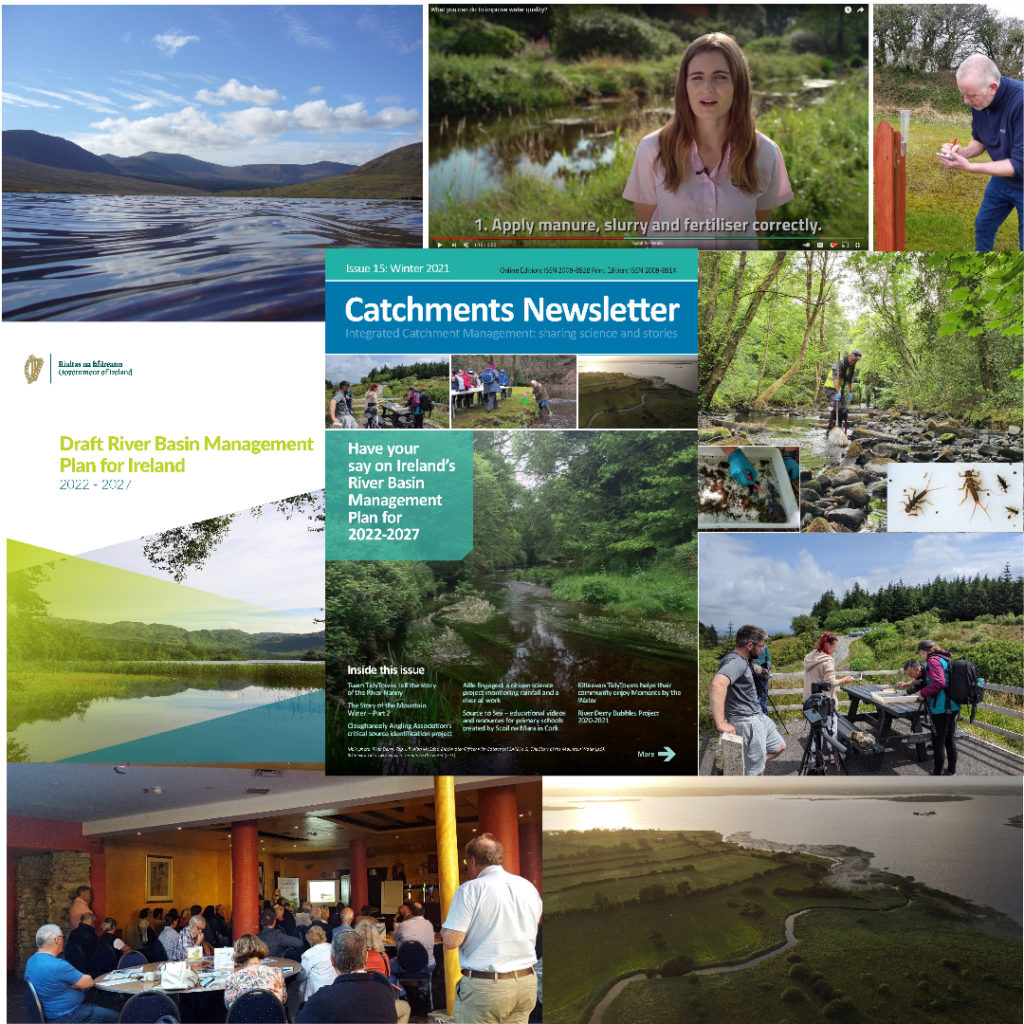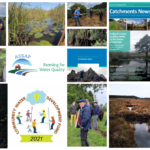The latest issue of the Catchments Newsletter is now available…
Catchments Newsletter – sharing science and stories about water in Ireland.
Every six years, Ireland prepares a River Basin Management Plan. The draft Plan for 2022-2027 is currently open for public consultation until 31 March 2022. This issue of the Catchments Newsletter has stories about the draft Plan and information on Ireland’s water quality, including how 2021 marked the fiftieth anniversary of Ireland’s river monitoring programme. We also have articles showing you where you can find out more about your local catchment, how LAWPRO can help you to have your say on the draft plan and some great stories from people all around Ireland who are acting to improve water quality.
In this issue:
Waters and communities news:
Tuam TidyTowns tell the story of the River Nanny; The Story of the Mountain Water – Part 2; Cloughaneely Angling Association’s critical source identification project; Aille Engaged: a citizen science project monitoring rainfall and a river at work; Source to Sea – educational videos and resources for primary schools created by Scoil na Mara in Cork; Kilteevan TidyTowns helps their community enjoy Moments by the Water; River Derry Bubbles Project 2020-2021.
Articles:
Public consultation opened on Ireland’s draft River Basin Management Plan for 2022-2027; Water Quality in 2020: An Indicators Report; EPA publishes an assessment of which catchments need reductions in nitrogen concentrations; EPA submission on the fourth review of Ireland’s Nitrate action Programme: EPA publishes 46 updated draft Catchment Assessments on catchments.ie to support public consultation on the draft River Basin Management Plan; Public consultation and local engagement on the draft River Basin Management Plan for Ireland 2022 – 2027; Ireland’s Quality Rating (Q-Value) River Monitoring System 1971-2021 – how 50 years of looking at what lives in our rivers can tell us about the health of our freshwater ecosystems; Local Authority Waters Programme launches their new website www.lawaters.ie; Ireland’s River Basin Management Plan: regional governance structures – what do they do?; Smart Farming Seminar: Sources and Solutions – the link between our soils & water quality; Nature-based Catchment Management – working with nature to benefit biodiversity, water and the climate; The Water Forum – working together for water quality; The Water Forum – fact sheet on the River Basin Management Plan.
Editorial
Past
As Ireland marks 100 years since the signing of the Treaty you might be interested to know that Ireland has had a national river monitoring programme for exactly half that time. This monitoring programme is called the Quality Rating system (Q-value) and it has been running since 1971. It assesses the biological quality of Irish rivers using insects (called aquatic invertebrates) that rely on water for at least part of their life cycle This is one of the longest-term environmental datasets of its kind available and provides useful information about the health of our freshwater river ecosystems. You can read more about the Q Value system and what it can tell us on page 25.
Present
Ireland’s water quality is declining, and this is impacting negatively on the health of our ecosystems and biodiversity as well as posing a risk to our health, recreation and economic activities. The main threat is high nutrient levels, such as phosphorus and nitrogen which come from human and animal activities. Nitrogen levels in rivers, groundwater, and estuaries in the south, southeast and east of Ireland are too high and increasing. This is primarily due to agricultural activities. The EPA has recently published an assessment of the scale of nitrogen reductions that are needed to achieve our water quality outcomes. You can read more about this, about water quality in Ireland generally, and about how to access an assessment of your local catchment on pages 18-22. Ireland’s current, 2nd cycle River Basin Management Plan runs from 2018 to 2021. This Plan launched a new approach to protecting and improving Ireland’s waters. This has included the creation of the Local Authority Waters Programme and the establishment of new national and regional governance structures which are based on an important principle of collaborating and working together. You can read more about the different elements of the governance structures and how they work together on page 31. A key focus of the current Plan is much greater involvement of local communities. This issue includes seven fantastic stories about what communities are doing to protect and enhance their local waterways on pages 4-15. You can also read about some new short videos the IFA Smart Farming programme has launched that highlight some practical steps farmers can take to improve water quality in their catchments on page 33. A national Water Forum has also been established to strengthen stakeholder input into our decision-making on water. The Water Forum advises on national water policy and works with stakeholders on achieving a shared vision of clean and healthy waters – see page 36 to learn more.
Future
There is a growing recognition about the merits of using nature-based solutions to improve water quality as they often bring multiple other environmental benefits. The potential use of nature-based solutions for catchment management in Ireland has been examined by a working group co-chaired by the EPA and OPW. You can read about this work and its potential to help develop measures with multiple benefits for climate, water and biodiversity on page 34. Every six years, Ireland prepares a River Basin Management Plan. The draft Plan for 2022-2027 is currently open for public consultation (see pages 16 and 23). You can make a submission on the Plan and have your say on the future of Ireland’s waters between now and 31 March 2022. The Local Authority Waters Programme shows how you can make a submission on the Plan (page 26) and highlights the resources available on their website (page 29). Finally, a factsheet on the Plan from An Fóram Uisce is on page 38. We would encourage every reader of this Newsletter to make a submission on the draft Plan before 31 March 2022.








